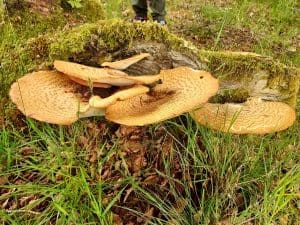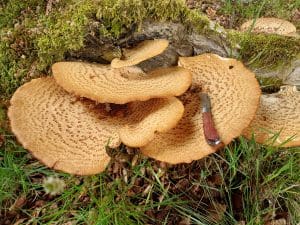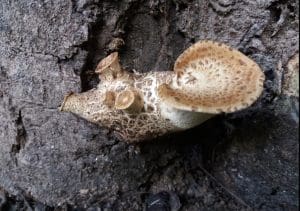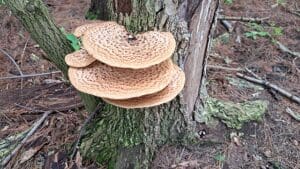Dryads Saddle / Summer / Autumn / Edible
Step into the enchanting realm of the forest, where the magnificent Dryad’s Saddle (Cerioporus squamosus) awaits to captivate your senses.
Join us on a journey of culinary exploration as we unravel the delights of this edible mushroom. With its large, saucer-shaped cap and distinctive scales resembling a mythical saddle, the Dryad’s Saddle is a sight to behold. Discover its preferred habitats, learn to identify its unique features, and delve into the culinary possibilities it offers. From its tender texture to its delicate flavor, this mushroom has the potential to elevate your culinary creations to new heights.
Whether you are an adventurous forager or a curious food enthusiast, let the Dryad’s Saddle be your guide into a world of delectable surprises. Embrace the magic of nature’s bounty and allow the captivating Dryad’s Saddle to enchant your taste buds with its versatile culinary applications.
Prepare to embark on a gastronomic adventure as we celebrate the edible wonders that lie within the depths of the forest.
Scientific Name
Cerioporus squamosus
Common Names
Dryad’s Saddle, Pheasant back mushroom
Family
Polyporaceae
Habitat
They can be found on dead broad-leaved stumps and logs and on living broad-leaf trees. They are saprotrophic and cause white rot.
Description
A fairly easy to identify mushroom, they are fairly common and can grow to a huge size. They quite often grow in overlapping tiers and have an unusual watermelon flavour when young.
Identifying Features for Dryads Saddle:
Cap:
A large fan shaped cap, upto 50 cm across. Brown to yellow in colour and covered with dark ‘scales’ that form in concentric bands.

Stem:
They can be up to 6 cm long, they are very solid and darken towards the base becoming almost velvety.
Pores:
The underside is a lot paler than the top and is covered in angular pores.

Smell:
No strong smell when young they have a pleasant mushroom smell as they age..
Spores:
White.
Uses
Edible Uses for Dryads Saddle
When young and tender they have an unusual watermelon/cucumber flavour. They become more mushroomy as they age but they can become very tough. I usually trim off the more tender edges and then dry and powder them for mushroom stock.
Known hazards
None known.
Potential lookalikes
It’s quite a distinctive mushroom and quite beginner friendly. The only thing it could be confused with is the Birch Polypore (Piptoporus betulinus); this is exclusive to birch, lacks the ‘scales’ and is non-toxic.
Extra notes from the Foragers
The name Dryad’s saddle comes from the Greek mythology, Dryads were a nymph or nature spirits who lived in trees and they supposedly rode this mushroom. (they do look a bit like old tractor seats)









